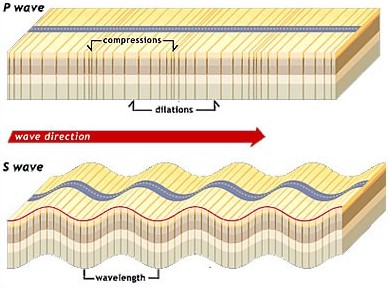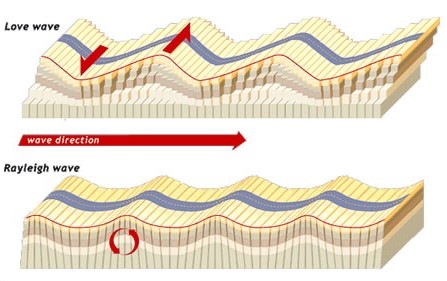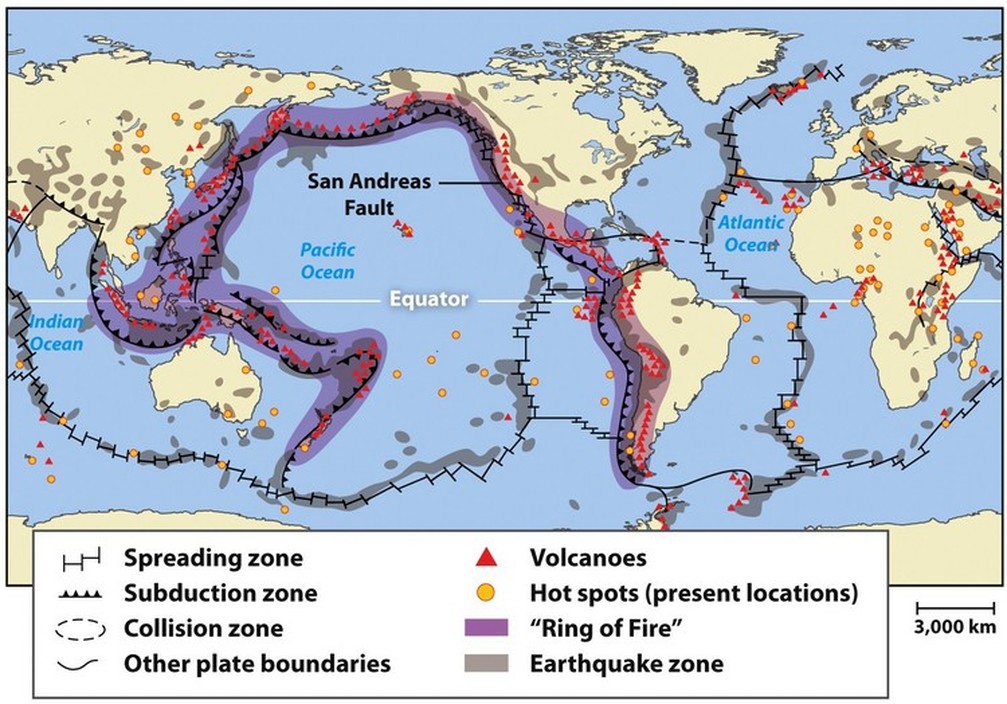India and Earthquakes
2023 FEB 16
Mains >
Disaster Management > Disaster mitigation > Earthquakes
IN NEWS:
- Following the devastating earthquakes in Turkey and Syria, some researchers are predicting massive tremors around India, Afghanistan and the Pakistan region.
WHAT ARE EARTHQUAKES:
- Earthquakes are the sudden shaking of the ground caused by the passage of seismic waves through Earth’s rocks.
- They are caused mostly by rupture of geological faults but also by other events such as volcanic activity, landslides, mine blasts and nuclear tests.
- All natural earthquakes take place in the lithosphere.
- Hypocenter (Focus): It is the point of origin of an earthquake or a subsurface nuclear explosion. It is the position where the strain energy stored in the rock is first released, marking the point where the fault begins to rupture.
- Epicenter: It is the point on the Earth's surface directly above a hypocenter or focus, the point where an earthquake or an underground explosion originates. In most earthquakes, the epicenter is where the greatest damage takes place.

- The earthquake events are scaled either according to the magnitude or intensity of the shock.
- The magnitude relates to the energy released during the quake. The magnitude scale is known as the Richter scale. The magnitude is expressed in absolute numbers, 0-10.
- The intensity scale takes into account the visible damage caused by the event. The intensity scale is named after Mercalli, an Italian seismologist. The range of intensity scale is from 1-12.
- Devices called seismometers are used to measure earthquakes.
- Isoseismal line connects points on the Earth's surface at which earthquake intensity is the same. It is usually a closed curve around the epicenter.
TYPES OF SEISMIC WAVES:
- Body waves: They are generated due to the release of energy at the focus and move in all directions travelling through the body of the earth. There are two types of body waves.
- Primary waves:
- P waves move faster and are the first to arrive at the surface.
- P waves cause the ground to compress and expand in the direction of travel.
- They are similar to sound waves and can travel through gaseous, liquid and solid materials.
- Secondary waves:
- S-waves arrive at the surface with some time lag.
- They travel only through solid materials. Hence, they have a larger shadow zone compared to P waves.

- Surface waves: The body waves interact with the surface rocks and generate new set of waves called surface waves. These waves move along the surface. S waves shake the ground in a shearing, or crosswise, motion that is perpendicular to the direction of travel. There are two types of surface waves:
- Love waves: Love waves move the ground from side to side in a horizontal plane but at right angles to the direction of propagation.
- Rayleigh waves: Also known as ground roll, these waves spread through the ground as ripples, similar to rolling waves on the ocean. They move both vertically and horizontally in a vertical plane pointed in the direction in which the waves are travelling.

TYPES OF EARTHQUAKES:
- Tectonic earthquakes:
- The most common form of earthquakes, it is caused by the movement of tectonic plates. They are the most widely studied type.
- Volcanic earthquake:
- These earthquakes happen before or after the eruption of a volcano. It is caused when magma leaving the volcano are filled by rocks being pushed to the surface. These are confined to areas of active volcanoes.
- Collapse earthquake:
- This earthquake occurs in underground mines. The main cause is due to pressure generated within the rocks.
- Explosion earthquakes:
- The occurrence of this type of earthquake is artificial in nature. High-density explosion such as nuclear explosions is the primary cause.
- Reservoir induced earthquakes:
- The earthquakes that occur in the areas of large reservoirs are referred to as reservoir induced earthquakes.
- The Koyna-Warna area of India is one of the best worldwide examples of reservoir-induced seismicity.
DISTRIBUTION OF EARTHQUAKES:
- Earth’s major earthquakes occur mainly in belts coinciding with the margins of tectonic plates:
- Circum-Pacific belt:
- This belt includes the boundary of the Pacific plate, covering areas of Alaska, Aleutian Islands, Japan, Philippines and the western coasts of Americas. This zone accounts for 68% of all earthquakes on earth.
- Mediterranean belt:
- This belt was created as a result of the convergence of Eurasian and Indian plates. This belt begins from the Alps, passes through the Mediterranean and extends to the Himalayas.
- Other areas:
- The Mid-Atlantic ridge region and the African rift valley region witness occasional earthquakes.

INDIA’S EARTHQUAKE VULNERABILITY:
- Considering the recorded history of earthquakes, around 59% of the land mass of India is prone to earthquakes of different intensities.
- The reason for the intensity and high frequency of earthquakes is the Indian plate driving into the Eurasian plate.
- Kangra (1905), Assam (1950), Bhuj (2001) and the Indian ocean earthquake (2004) were some of the most devastating quakes in recent history.
- The Bureau of Indian Standards has classified regions in India into four seismic zones on the basis of historical seismic activity.
- Zone V covers the very high-risk areas such as the entire northeastern India, Andaman & Nicobar Islands, parts of Himalayan states and Rann of Kutch.
- Zone IV comprises of high-risk zones. It includes parts of Jammu, Himachal Pradesh, New Delhi, Sikkim, Uttar Pradesh, Bihar and West Bengal, Gujarat and small portions of Maharashtra.
- Zone III covers areas of moderate risk, such as the western coast and Narmada-Tapti River basin.
- Zone II covers low risk zones. It includes the continental shield areas of the country, such as the Karnataka Plateau.
.png)
INDIA’S EARTHQUAKE PREPAREDNESS:
- National Centre for Seismology:
- Under the Ministry of Earth Sciences, NCS is the nodal agency for monitoring earthquakes in and around the country.
- NCS maintains a National Seismological Network (NSN) consisting of 115 observatories spread across the country.
- National Disaster Management Authority:
- The NDMA has laid down the institutional and coordination mechanisms for effective disaster management. It has also established guidelines for effective management of earthquakes.
- National Seismic Risk Mitigation Programme (NSRMP):
- It is a key component of the National Cyclone Risk Mitigation Project.
- It encompasses activities that will strengthen risk assessment capabilities, raising public awareness, strengthening of building codes and land-use regulations, piloting retrofitting of critical infrastructure, and developing risk financing framework.
- National Information Center of Earthquake Engineering:
- It is an initiative intended to collect and maintain information resources on Earthquake Engineering and make these available to the interested professionals, researchers, academicians and others with a view to mitigate earthquake disasters in India.
- Building codes and standards:
- The Bureau of Indian Standards (BIS) has developed seismic codes. The 1962 guidelines were revised in 2002 after the devastating Bhuj earthquake.
- Eg: IS 4326 covers general principles for earthquake resistant buildings such as selection of materials and special features of design and construction.
- ‘India Quake’:
- It is a mobile App developed by the NCS for automatic dissemination of earthquake parameter (location, time and magnitude) after the occurrence of earthquakes.
- Earthquake Disaster Risk Index:
- In 2019, the NDMA published an EDRI that looked specifically at 50 Indian cities to quantify their earthquake risk.
- International efforts:
- International Platform for Reducing Earthquake Disaster (IPRED):
- Supported by UNESCO, IPRED is a platform for collaborative research, training and education in the field of seismology and earthquake engineering.
- Sendai Framework for Disaster Risk Reduction 2015-2030:
- It is an international agreement that aims to prevent disaster risks across the globe.
- It aims to strengthen social and economic resilience to ease the adverse effects of climate change, manmade disasters and natural hazards.
- India is a signatory to the framework.
.png)
-
- Coalition for Disaster Resilient Infrastructure (CDRI):
- It is an international partnership of governments and other agencies that aims to promote the resilience of new and existing infrastructure systems to climate and disaster risks in support of sustainable development.
NDMA GUIDELINES FOR EARTHQUAKES:

- Earthquake-Resistant Design and Construction of New Structures: Past earthquakes show that over 95% of the lives lost were due to the collapse of buildings that were not earthquake-resistant.
- Seismic Strengthening and retrofitting of Lifeline and Priority Structures: it is not practically feasible or financially viable to retrofit all the existing buildings. Hence, the guidelines call for structural safety audit and retrofitting of select critical lifelines structures and high priority buildings.
- Regulation and Enforcement: A periodic revision of the codes and standards relating to earthquake-resistant construction will be undertaken by drafting groups within a fixed time-frame.
- Awareness and Preparedness: A comprehensive awareness campaign will be developed and implemented on the safe practices to be followed before, during and after an earthquake.
- Capacity Development: Appropriately designed science and technology courses and training programmes will be designed, with greater attention on improving earthquake education in India. The central and state government will encourage knowledge institutions to undertake research, teaching and training.
- Response: The management and control of the adverse consequences of future earthquakes will require coordinated, prompt and effective response systems. Systems need to be developed considering the multi-hazard scenario of various regions in order to optimally utilize available resources.
ISSUES IN EARTHQUAKE MANAGEMENT:
- Reactive approach:
- Despite the emphasis on a paradigm shift to disaster risk reduction approach in disaster management, most parts of the country continue to follow a relief-centric approach.
- Poor enforcement:
- There is inadequate monitoring and enforcement of earthquake-resistant building codes and town planning bye-laws. As a result, unsafe building practices, especially in urban settlements constitute one of India’s greatest challenges for disaster management.
- Weak preparedness:
- Though all of India’s states have departments of disaster management or relief and rehabilitation, they are still poorly prepared to lend support in times of disasters, according to the UN Development Programme (UNDP).
- Slow relief and rehabilitation:
- India’s relief and rehabilitation efforts are short-lived and unable to comprehensively or proactively deal with disasters. The efforts are often highly politicized and suffer from bureaucratic sluggishness. Also, the rehabilitation efforts rarely focus on the most vulnerable sections such as women or on aspects such as Psycho-Social support and mental health services.
- Flawed capacity development:
- There is a lack of awareness among various stakeholders about the seismic risk. Also, India has a shortage of formally trained professionals and experts in earthquake engineering and earthquake-proof construction practices.
- Delays in updating guidelines:
- The norms for earthquake protection, such as building codes, have remained unrevised for over a decade, despite India being hit by multiple major earthquakes.
- Shortage of resources:
- In a developing country like India, other competing needs and priorities such as poverty reduction, social welfare, education etc. require greater attention and funding. Hence, it is difficult to obtain political and economic commitments towards investing in disaster management.
WAY FORWARD:
- Risk reduction approach: The prevailing post-disaster reaction cycle should be changed into a pre-disaster pro-action cycle. There should be well-established guidelines on relief and rehabilitation plans and an accountable organizational hierarchy to execute the same.

- Inclusive policies:
- Disaster management policies must incorporate programs to protect the most vulnerable segments of society—the poor, marginalized, women, children, disabled, and elderly.
- Strengthen knowledge base:
- Mechanisms must be designed and adopted for transferring lessons learned for pre- and post-disaster management between communities. IT enabled services must be utilized for better evaluation of vulnerabilities, especially in the high-risk areas such as North East India.
- Update guidelines and codes:
- The periodic review and updating of such codes and guidelines is essential. The integration of safety norms with all development and construction activities needs to be ensured. Building laws or rules should be formulated.
- Capacity building:
- The presence of trained manpower is vital disaster management activities. For the same, the various governments must invest in developing awareness among the masses, create a cadre of dedicated relief workers and involve philanthropic agencies in disaster management.
- Risk transfer:
- Compulsory insurance of people and buildings in highly vulnerable areas should be prospected.
- Academy support:
- State must take measures to incorporate disaster management as an essential part of school curriculum. Also, skilling agencies must be developed to create a cadre of licensed engineers and masons capable of creating quake-proof constructions.
|
CASE STUDY: The Assam-Type Housing
The Assam type houses are a type of traditional construction practice which has the potential to emerge again as one of the most sustainable and earthquake-safe housing. It is a timber building type and is most common throughout the Northeast India. These houses are made with walls of bamboo or reed mesh (known locally as ikora) and plaster set in a wooden framework. They have a light tin roof and wooden floors. The buildings are light, flexible and able to move with the swaying caused by tremors, without there being extensive damage or casualties.
|
PRACTICE QUESTION:
Q. Discuss about the vulnerability of India to earthquake related hazards. Give examples including the salient features of major disasters caused by earthquakes in different parts of India during the last three decades. (UPSC GS 3, 2021)
Q. The frequency of earthquakes appears to have increased in the Indian subcontinent. However, India’s preparedness for mitigating their impact has significant gaps. Discuss various aspects. (UPSC GS 3, 2015)




.png)
.png)

